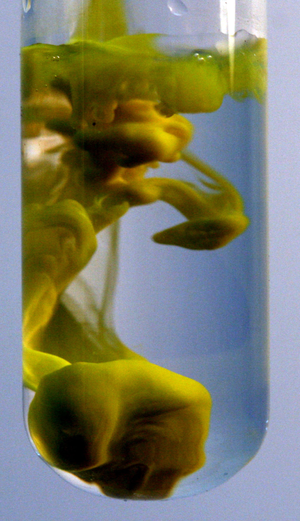Difference between revisions of "Precipitate"
(Created page with "==Key Stage 4== ===Meaning=== A precipitate is a solid insoluble compound formed by the chemical reaction between two other chemicals...") |
|||
| (5 intermediate revisions by 2 users not shown) | |||
| Line 1: | Line 1: | ||
==Key Stage 4== | ==Key Stage 4== | ||
| + | [[File:PrecipitateLeadIodide.png|right|300px|thumb|A [[precipitate]] of Lead Iodide formed in the reaction between Lead Nitrate and [[Potassium Iodide]].]] | ||
===Meaning=== | ===Meaning=== | ||
A [[precipitate]] is a [[solid]] [[insoluble]] [[compound]] formed by the [[Chemical Reaction|chemical reaction]] between two other [[chemical]]s in [[solution]]. | A [[precipitate]] is a [[solid]] [[insoluble]] [[compound]] formed by the [[Chemical Reaction|chemical reaction]] between two other [[chemical]]s in [[solution]]. | ||
| + | |||
| + | ===About Precipitates=== | ||
| + | : The [[reactant]]s in a '''precipitation''' [[Chemical Reaction|reaction]] are [[aqueous]] or [[gas]]eous but at least one of the [[product]]s is an [[insoluble]] [[solid]]. | ||
| + | : Some common [[precipitate]] [[Chemical Reaction|reactions]] you may know are: | ||
| + | : ''Lead Nitrate + [[Potassium Iodide]] → [[Potassium Nitrate]] + Lead Iodide'' | ||
| + | <math>Pb(NO_3)_2(aq) + 2KI(aq) → 2KNO_3(aq) + PbI_2(s)</math> | ||
| + | |||
| + | : ''[[Calcium Oxide]] + [[Carbon Dioxide]] → [[Calcium Carbonate]]'' | ||
| + | <math>CaO(aq) + CO_2(g) → CaCO_3(s)</math> | ||
| + | |||
| + | ===References=== | ||
| + | ====AQA==== | ||
| + | |||
| + | :[https://www.amazon.co.uk/gp/product/0008158762/ref=as_li_tl?ie=UTF8&camp=1634&creative=6738&creativeASIN=0008158762&linkCode=as2&tag=nrjc-21&linkId=a0fffa35b3ea49a63404f6704e0df7cc ''Precipitate, precipitation, pages 195, 210, 200, 263, 276-9, GCSE Chemistry; Student Book, Collins, AQA ''] | ||
| + | :[https://www.amazon.co.uk/gp/product/0008158762/ref=as_li_tl?ie=UTF8&camp=1634&creative=6738&creativeASIN=0008158762&linkCode=as2&tag=nrjc-21&linkId=a0fffa35b3ea49a63404f6704e0df7cc ''Precipitate. Precipitation; gelatinous, page 276, GCSE Chemistry; Student Book, Collins, AQA ''] | ||
| + | :[https://www.amazon.co.uk/gp/product/1782945598/ref=as_li_tl?ie=UTF8&camp=1634&creative=6738&creativeASIN=1782945598&linkCode=as2&tag=nrjc-21&linkId=ad276ad49df77ab4b40ab4fd0fe10190 ''Precipitates, page 141, GCSE Combined Science; The Revision Guide, CGP, AQA ''] | ||
| + | :[https://www.amazon.co.uk/gp/product/1782945571/ref=as_li_tl?ie=UTF8&camp=1634&creative=6738&creativeASIN=1782945571&linkCode=as2&tag=nrjc-21&linkId=9e29fad914244909903e5e93f8a01d212 ''Precipitates, pages 69, 70, 88, 89, GCSE Chemistry; The Revision Guide, CGP, AQA ''] | ||
| + | |||
| + | ====Edexcel==== | ||
| + | |||
| + | :[https://www.amazon.co.uk/gp/product/1292120207/ref=as_li_tl?ie=UTF8&camp=1634&creative=6738&creativeASIN=1292120207&linkCode=as2&tag=nrjc-21&linkId=22455ff53961978667722edaa64c0be5 ''Precipitates, page 14, GCSE Biology, Pearson, Edexcel ''] | ||
| + | :[https://www.amazon.co.uk/gp/product/1292120215/ref=as_li_tl?ie=UTF8&camp=1634&creative=6738&creativeASIN=1292120215&linkCode=as2&tag=nrjc-21&linkId=8f96ddb76196848bafdb124354e4cf77 ''Precipitates, pages 14, 68, 74, 196, GCSE Chemistry, Pearson, Edexcel ''] | ||
| + | |||
| + | ====OCR==== | ||
| + | :[https://www.amazon.co.uk/gp/product/0198359829/ref=as_li_tl?ie=UTF8&camp=1634&creative=6738&creativeASIN=0198359829&linkCode=as2&tag=nrjc-21&linkId=90e8d7b4f039d53035238fa0320fe00b ''Precipitates, pages 90, 95, 276, Gateway GCSE Chemistry, Oxford, OCR ''] | ||
Latest revision as of 16:07, 18 December 2019
Contents
Key Stage 4
Meaning
A precipitate is a solid insoluble compound formed by the chemical reaction between two other chemicals in solution.
About Precipitates
- The reactants in a precipitation reaction are aqueous or gaseous but at least one of the products is an insoluble solid.
- Some common precipitate reactions you may know are:
- Lead Nitrate + Potassium Iodide → Potassium Nitrate + Lead Iodide
\(Pb(NO_3)_2(aq) + 2KI(aq) → 2KNO_3(aq) + PbI_2(s)\)
\(CaO(aq) + CO_2(g) → CaCO_3(s)\)
References
AQA
- Precipitate, precipitation, pages 195, 210, 200, 263, 276-9, GCSE Chemistry; Student Book, Collins, AQA
- Precipitate. Precipitation; gelatinous, page 276, GCSE Chemistry; Student Book, Collins, AQA
- Precipitates, page 141, GCSE Combined Science; The Revision Guide, CGP, AQA
- Precipitates, pages 69, 70, 88, 89, GCSE Chemistry; The Revision Guide, CGP, AQA
Edexcel
- Precipitates, page 14, GCSE Biology, Pearson, Edexcel
- Precipitates, pages 14, 68, 74, 196, GCSE Chemistry, Pearson, Edexcel
